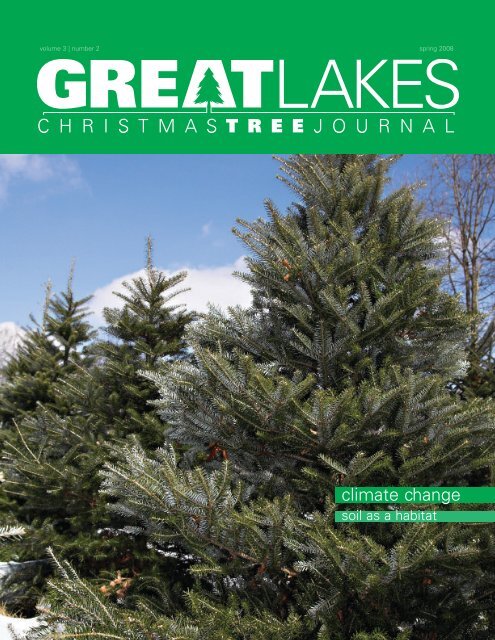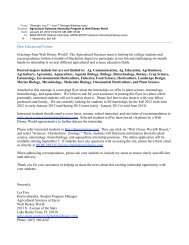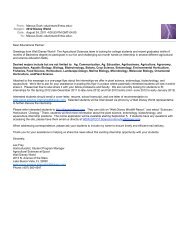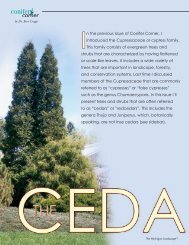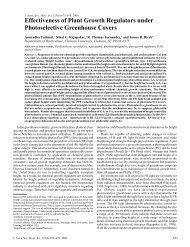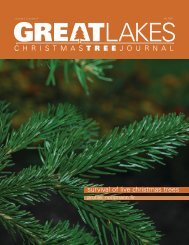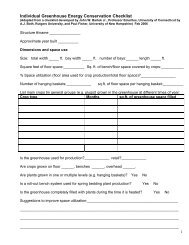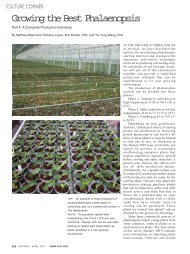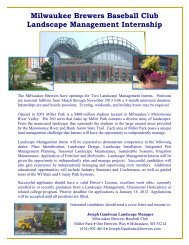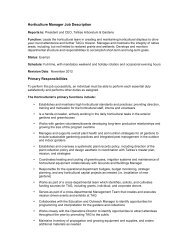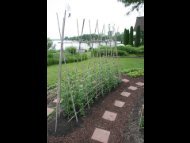Korean fir - Department of Horticulture - Michigan State University
Korean fir - Department of Horticulture - Michigan State University
Korean fir - Department of Horticulture - Michigan State University
You also want an ePaper? Increase the reach of your titles
YUMPU automatically turns print PDFs into web optimized ePapers that Google loves.
volume 3 | number 2 spring 2008<br />
climate change<br />
soil as a habitat
species pr<strong>of</strong>ile<br />
spring 2008<br />
great lakes christmas tree journal<br />
Christmas Tree Species Pr<strong>of</strong>ile:<br />
<strong>Korean</strong> <strong>fir</strong> Abies koreana<br />
Bert Cregg, Ph.D. <strong>Michigan</strong> <strong>State</strong> <strong>University</strong>, <strong>Department</strong> <strong>of</strong> <strong>Horticulture</strong> and <strong>Department</strong> <strong>of</strong> Forestry<br />
Recently we started a new series <strong>of</strong> articles for the Great Lakes Christmas Tree<br />
Journal pr<strong>of</strong>iling conifer species used as Christmas trees in the Great Lakes region.<br />
Some <strong>of</strong> the conifers we’ll discuss in the series are well known and widely used as<br />
Christmas trees. Others are perhaps less familiar but possess attributes that make<br />
them interesting nevertheless. The goal <strong>of</strong> the species pr<strong>of</strong>iles is to provide growers<br />
with background information on interesting conifers including the ecological and cultural<br />
characteristics as well and some trivial or other interesting tidbits. This issue’s featured<br />
conifer is <strong>Korean</strong> <strong>fir</strong> Abies koreana.<br />
Abies koreana ‘Aurea’ is a popular form <strong>of</strong><br />
<strong>Korean</strong> <strong>fir</strong> in the landscape nursery trade.<br />
4
This slow growing form <strong>of</strong> A. koreana makes an attractive foundation<br />
plant.<br />
Botanical characteristics: In its<br />
native environment, <strong>Korean</strong> <strong>fir</strong> is a small<br />
to medium tree, growing up to 50–70'. As<br />
indicated by its common and scientific<br />
names, <strong>Korean</strong> <strong>fir</strong> is native to the <strong>Korean</strong><br />
peninsula. The native range is relatively<br />
small and the species occurs only on the<br />
southern end <strong>of</strong> the <strong>Korean</strong> peninsula<br />
and on Jeju island, just south <strong>of</strong> the<br />
<strong>Korean</strong> mainland. <strong>Korean</strong> <strong>fir</strong> occurs in<br />
cool moist areas on mountainsides at<br />
elevations between 3,000' and 6,000'.<br />
Taxonomically, Abies koreana is classified<br />
within the genus Abies in the section<br />
Balsamea, along with Abies fraseri, A.<br />
balsamea, A. lasiocarpa, and A. veitchii.<br />
Like many other plants from that region<br />
<strong>of</strong> the world, <strong>Korean</strong> <strong>fir</strong> is sufficiently<br />
cold hardy (USDA Hardiness zone 4) to<br />
thrive in the Upper Midwest, including<br />
most <strong>of</strong> lower <strong>Michigan</strong>. <strong>Korean</strong> <strong>fir</strong> tends<br />
to break bud later than other <strong>fir</strong>s making<br />
it less susceptible to late frost injury.<br />
Seventy five years ago in the<br />
Cultivated Conifers <strong>of</strong> North America,<br />
Liberty Hyde Bailey, in typical understatement,<br />
described <strong>Korean</strong> <strong>fir</strong> as “Hardy<br />
and attractive.” Both adjectives are appropriate<br />
and go a long ways in explaining<br />
continued interest in the species. First<br />
and foremost, A. koreana is one <strong>of</strong> the<br />
most forgiving <strong>fir</strong>s in terms <strong>of</strong> site<br />
requirements. <strong>Korean</strong> <strong>fir</strong> will grow well<br />
on a range <strong>of</strong> sites and is less restrictive<br />
in its preferred sites than Fraser <strong>fir</strong>.<br />
<strong>Korean</strong> <strong>fir</strong> needles are <strong>of</strong>ten described as<br />
dark green but <strong>of</strong>ten range toward bright<br />
green. Needles are relatively short and<br />
distributed along the stem in a bottlebrush<br />
arrangement, giving the tree a<br />
characteristic texture.<br />
Growers chime in: Anyone who has<br />
spent more than five minutes with Frank<br />
and Cathy Genovese <strong>of</strong> Candy Cane<br />
Christmas Tree farm in Oxford, <strong>Michigan</strong><br />
recognizes their enthusiasm for <strong>Korean</strong><br />
<strong>fir</strong>. “We started with 25 seedlings from the<br />
MSU exotic <strong>fir</strong> trial that we bought at a<br />
research auction”, Cathy remembers.<br />
“The seedlings had great, fibrous roots<br />
and grew into full, beautiful trees. We<br />
grew the <strong>fir</strong>st trees on to be 9–10' and we<br />
A. koreana is one <strong>of</strong> the most forgiving <strong>fir</strong>s in terms <strong>of</strong><br />
site requirements. <strong>Korean</strong> <strong>fir</strong> will grow well on a range <strong>of</strong><br />
sites and is less restrictive in its preferred sites than<br />
Fraser <strong>fir</strong>. <strong>Korean</strong> <strong>fir</strong> needles are <strong>of</strong>ten described as dark<br />
green but <strong>of</strong>ten range toward bright green.<br />
got great feedback from our customers.<br />
We asked some <strong>of</strong> them to keep the trees<br />
displayed until late January and they had<br />
great needle retention.” The Genovese’s<br />
continue to grow <strong>Korean</strong> <strong>fir</strong> and estimate<br />
it makes up about 20% <strong>of</strong> their choose<br />
and cut business. Dan Wahmh<strong>of</strong>f <strong>of</strong><br />
Wahmh<strong>of</strong>f farms in Gobles, <strong>Michigan</strong> is<br />
also a <strong>Korean</strong> <strong>fir</strong> fan. “There are lots <strong>of</strong><br />
5
species pr<strong>of</strong>ile<br />
spring 2008<br />
great lakes christmas tree journal<br />
Abies koreana x lasiocarpa. This hybrid<br />
combines the adaptability <strong>of</strong> <strong>Korean</strong> <strong>fir</strong><br />
with the form and color <strong>of</strong> sub-alpine <strong>fir</strong>.<br />
interesting exotic <strong>fir</strong>s out there,”<br />
Wahmh<strong>of</strong>f notes,“but <strong>Korean</strong> is about<br />
the only one that grows fast enough to<br />
make any economic sense. We’ve grown<br />
9–10 footers on about the same production<br />
cycle as our Frasers.”<br />
In the interest <strong>of</strong> being “Fair and<br />
Balanced”, it should be noted that<br />
<strong>Korean</strong> <strong>fir</strong> can present challenges that<br />
may dampen some grower’s enthusiasm<br />
for the species. The most obvious issue<br />
with <strong>Korean</strong> <strong>fir</strong> is cones. Most people<br />
familiar with Christmas tree production<br />
in <strong>Michigan</strong> recognize the problem <strong>of</strong><br />
precocious cone production in Fraser <strong>fir</strong>,<br />
however coning in <strong>Korean</strong> <strong>fir</strong> occurs<br />
even earlier in the tree’s development<br />
and more frequently than in Fraser <strong>fir</strong>. In<br />
fact, <strong>Korean</strong> <strong>fir</strong>’s propensity for pr<strong>of</strong>use<br />
cone production has caught the eye <strong>of</strong><br />
nursery growers over the years and sever-<br />
3737 – 65 th Street<br />
Holland, MI 49423<br />
Phone: 269/857-7804<br />
E-mail: info@alphanurseries.com<br />
Fax: 269/857-8162<br />
Need a reliable source for Transplants?<br />
Balsam Fir<br />
Canaan Fir<br />
<strong>Korean</strong> Fir<br />
White Spruce<br />
Douglas Fir<br />
Concolor Fir<br />
Colorado Blue Spruce<br />
White Pine<br />
Fraser Fir<br />
Corkbark Fir<br />
Norway Spruce<br />
Austrian Pine<br />
Contact us today for high quality,<br />
fairly priced lining out stock and complete seedling list.<br />
... Always with the special attention that you’ve come to expect!<br />
Jeff Busscher, Manager<br />
6
al ornamental cultivars <strong>of</strong> <strong>Korean</strong> <strong>fir</strong><br />
have been selected for their distinctive<br />
cones (see below). Needle color can<br />
also be a potential issue for <strong>Korean</strong> <strong>fir</strong>.<br />
As noted earlier, <strong>Korean</strong> <strong>fir</strong> is sometimes<br />
described as dark green in the literature<br />
but, compared to many <strong>fir</strong>s, bright green<br />
is probably a better description. As soil<br />
nutrients become limiting, <strong>Korean</strong> <strong>fir</strong> can<br />
quickly slip from bright green to a<br />
chlorotic yellow-green. <strong>Korean</strong> <strong>fir</strong> also<br />
has a bit <strong>of</strong> a reputation for producing<br />
squirrelly leaders once pruned. Lou<br />
Waldock <strong>of</strong> Waldock farms in Howell,<br />
<strong>Michigan</strong> believes <strong>Korean</strong> tops can be<br />
tamed, however. “Sometimes the terminal<br />
leader can get a little curly,” Waldock<br />
notes,“but we’ve had good success in<br />
training new leaders from laterals.”<br />
Hybrids on the horizon: Many <strong>fir</strong><br />
species hybridize readily and <strong>Korean</strong> <strong>fir</strong><br />
is an obvious choice for hybridization<br />
since it cones readily and has many<br />
desirable adaptive and ornamental<br />
traits. Several <strong>Korean</strong> <strong>fir</strong> hybrids are<br />
available from seedling nurseries<br />
including A. koreana x fraseri,A. koreana<br />
x veitchii, and A. koreana x lasiocarpa.<br />
The goals <strong>of</strong> crossing species<br />
are usually to combine desirable traits,<br />
produce a plant that is intermediate<br />
between two species, or to produce<br />
‘hybrid vigor’— a cross that is superior<br />
to either parent alone. A hybrid <strong>of</strong> A.<br />
koreana and A. lasiocarpa (see photo)<br />
appears to combine desirable traits<br />
from both species, combining the<br />
adaptability <strong>of</strong> <strong>Korean</strong> with the bluish<br />
needles <strong>of</strong> sub-alpine <strong>fir</strong>. It is important<br />
to note that species hybrids can <strong>of</strong>ten<br />
produce surprises. For example, in the<br />
MSU exotic <strong>fir</strong> trials, <strong>Korean</strong> and Vietch<br />
<strong>fir</strong> were consistently among the last<br />
species to break bud each spring—a<br />
desirable trait since it minimizes risk <strong>of</strong><br />
late frost damage. Nevertheless, trees<br />
from a cross between <strong>Korean</strong> and Vetch<br />
<strong>fir</strong> broke bud two to three weeks earlier<br />
than trees from either parent species<br />
and were damaged by a late freeze in<br />
2004. There are a number <strong>of</strong> possible<br />
causes for this phenomenon; the seed<br />
sources used to make the cross could<br />
have been different than the seed<br />
sources <strong>of</strong> the parent species tested or<br />
the cross produced a hybrid vigor (earlier<br />
budbreak than the parents) which<br />
in this case resulted in a negative trait.<br />
The take home message is that we cannot<br />
assume hybrids will be superior or<br />
even intermediate to the parent<br />
species. Each hybrid cross needs to be<br />
evaluated on its own merits.<br />
Clamp-Type Wreath Frames & Machines<br />
Shakers &<br />
Other Equipment<br />
Stands – Cinco, Yule Tree,<br />
Gunnard and More<br />
Polyurethane Balers<br />
& Netting<br />
Shearing Equipment<br />
Colorants<br />
SUPPLIES + EQUIPMENT<br />
We select and <strong>of</strong>fer the best-working products!<br />
BALERS • NETTING • WREATH-MAKING SUPPLIES • SHAKERS • TREE STANDS<br />
TAGS • COLORANTS • BANNERS • SHEARING MACHINES • REMOVAL BAGS & MORE<br />
As an experienced grower and retailer, we can help you select products for a more productive and pr<strong>of</strong>itable business.<br />
1-877-352-7355 • www.fraserknoll.com<br />
384 BURNT HILL ROAD • LAUREL SPRINGS, NC 28644 • PHONE/FAX: 336-982-3517
species pr<strong>of</strong>ile<br />
spring 2008<br />
great lakes christmas tree journal<br />
Abies koreana ‘Silberlocke’. The recurved needles on<br />
this cultivar make it a silvery showstopper.<br />
The list below provides a cross-section<br />
<strong>of</strong> the <strong>Korean</strong> cultivars that are in the<br />
nursery trade.<br />
• ‘Silberlocke’ Silberlocke is one <strong>of</strong> a<br />
series <strong>of</strong> <strong>Korean</strong> <strong>fir</strong> cultivars that feature<br />
recurved, or upturned, needles.<br />
The recurved needles display the silvery<br />
bands <strong>of</strong> stomata on the underside<br />
<strong>of</strong> the needles. The result is a<br />
striking silver appearance that gives<br />
the cultivar its name since Silber is<br />
German for silver.<br />
• ‘Blue cones’ As the name implies,<br />
the <strong>Korean</strong> <strong>fir</strong> cultivar was selected<br />
for its prolific blue cones.<br />
• ‘Compact dwarf’ This cultivar <strong>of</strong><br />
<strong>Korean</strong> <strong>fir</strong> is characterized by its slow<br />
growth rate. The American Conifer<br />
Society denotes dwarf conifers as<br />
those that growth between 1" to 6"<br />
per year and typically reach about<br />
1' to 6' in height by age 10. As with<br />
many ornamental conifers, ‘Compact<br />
dwarf’ lacks apical dominance and<br />
therefore appears more as a shrub<br />
than a tree.<br />
• ‘Aurea’ This is a yellow form <strong>of</strong><br />
<strong>Korean</strong> <strong>fir</strong>. Christmas tree growers<br />
accustomed to striving for dark green<br />
color, might have to be physically<br />
restrained to keep from adding more<br />
fertilizer to this one.<br />
Landscape cultivars: Although the<br />
number <strong>of</strong> Christmas tree growers in<br />
<strong>Michigan</strong> dabbling in <strong>Korean</strong> <strong>fir</strong> is<br />
increasing, the species is probably more<br />
widely known as a landscape ornamental.<br />
The American Conifer Society (ACS)<br />
recognizes roughly 40 cultivars <strong>of</strong> <strong>Korean</strong><br />
<strong>fir</strong>. Some cultivars are obscure, but others<br />
are fairly well known and maybe<br />
worth considering for growers that are<br />
expanding into landscape nursery production.<br />
8


